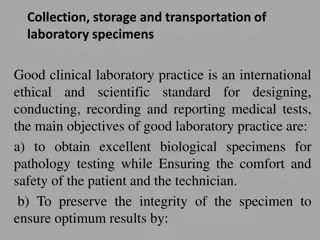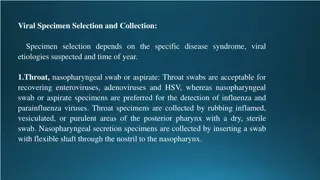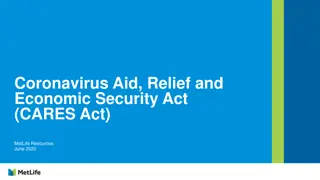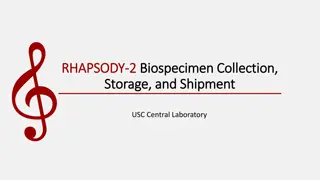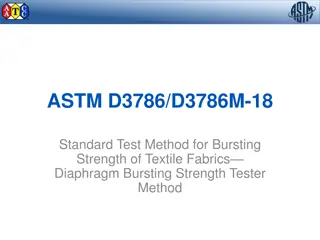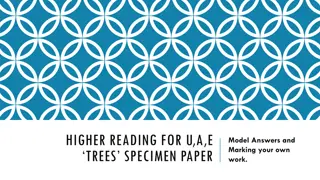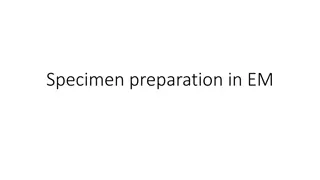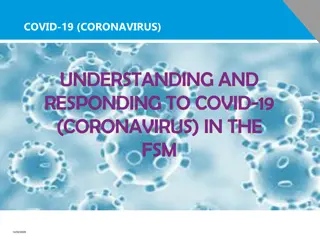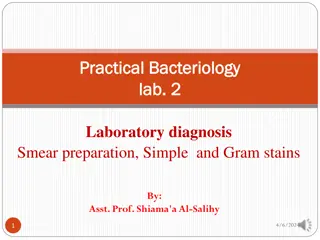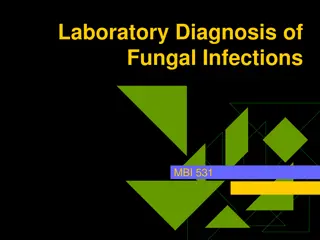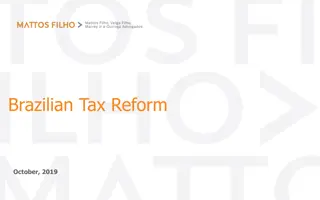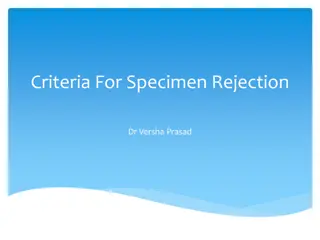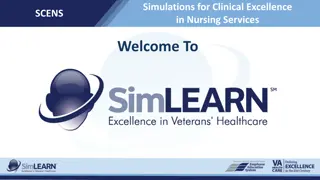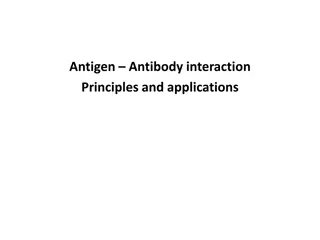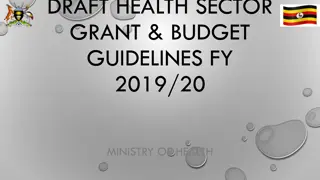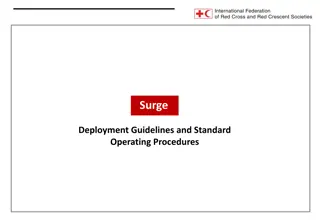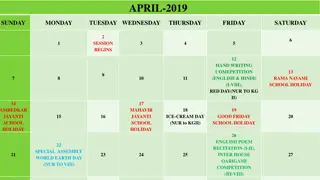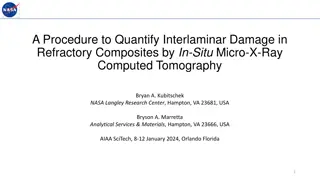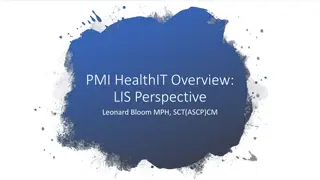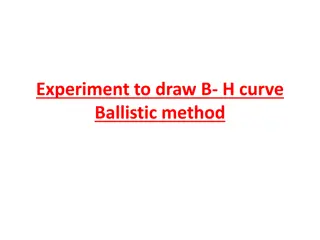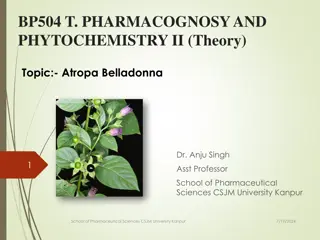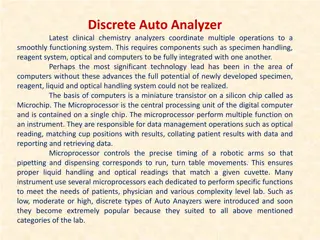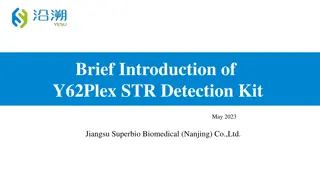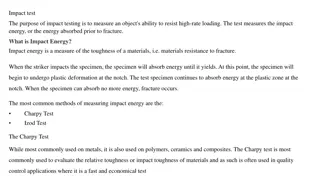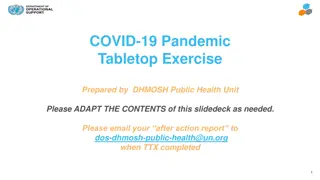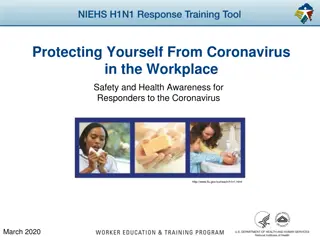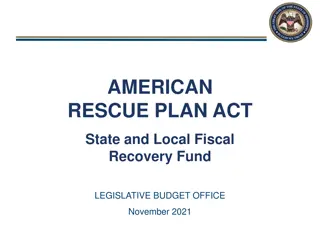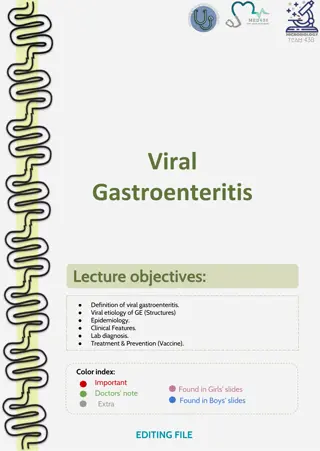Guidelines for 2019 Novel Coronavirus Specimen Collection
The guidelines outline the responsibilities of clinicians in collecting clinical specimens for testing 2019-nCoV, emphasizing the importance of following case definitions and using proper procedures for specimen collection, packaging, and transport. It also provides details on selecting patients for testing and the types of specimens to collect, how to store and transport them, and the necessary precautions to take to ensure accurate testing results.
Download Presentation

Please find below an Image/Link to download the presentation.
The content on the website is provided AS IS for your information and personal use only. It may not be sold, licensed, or shared on other websites without obtaining consent from the author. Download presentation by click this link. If you encounter any issues during the download, it is possible that the publisher has removed the file from their server.
E N D
Presentation Transcript
Specimen Collection, Packaging and Transport Guidelines for 2019 novel Corona virus Specimen Collection, Packaging and Transport Guidelines for 2019 novel Corona virus State Institute of Health & Family Welfare Rajasthan 1
Responsibilities Responsibilities The clinician should decide necessity for collection of clinical specimens for laboratory testing of 2019- nCoV only after following the case definition as given by the health authorities, Government of India. Appropriate clinical sample need to be collected by laboratory personnel/ health care worker trained in specimen collection in presence of a clinician. By following all biosafety precautions and using personal protective equipment (PPEs), clinical samples need to be sent to the designated laboratory by following standard triple packaging. 2
Selection of patient Any person present with Severe Acute Respiratory Illness (SARI); has travel history; disease in healthcare worker working in an environment of SARI patients; unusual or unexpected clinical course, especially sudden deterioration despite appropriate treatment; should be urgently investigated. Updated case definition need to be followed as per MOHFW, Govt of India which is available on the website www.mohfw.gov.in Selection of patient 3
Specimen collection details (Adapted from the WHO guidelines on 2019 Specimen type Collection materials laboratory Nasopharyngeal and oropharyngeal swab flocked swabs* Specimen collection details (Adapted from the WHO guidelines on 2019- -nCoV) Transport nCoV) Storage till testing Comment to Dacron or polyester 5 days: 4 C >5 days: -70 C The nasopharyngeal and oropharyngeal swabs should be placed in the same tube to increase the viral load. There may be some dilution of pathogen, but still a worthwhile specimen 4 C Bronchoalveolar lavage 48 hours: 4 C >48 hours: 70 C sterile container* 4 C *For transport of samples for viral detection, use VTM (viral transport medium) containing antifungal and antibiotic supplements. Avoid repeated freezing and thawing of specimens. 4
Specimen collection details (Adapted from the WHO guidelines on 2019 Specimen type Collection materials laboratory Tracheal aspirate, nasopharyngeal aspirate or nasal wash Specimen collection details (Adapted from the WHO guidelines on 2019- -nCoV) Transport nCoV) Storage till testing to Comment sterile container* 4 C Not applicable 48 hours: 4 C >48 hours: 70 C 48 hours: 4 C >48 hours: 70 C Sputum sterile container 4 C Ensure the material is from the lower respiratory tract *For transport of samples for viral detection, use VTM (viral transport medium) containing antifungal and antibiotic supplements. Avoid repeated freezing and thawing of specimens. 5
Specimen collection details (Adapted from the WHO guidelines on 2019 Specimen collection details (Adapted from the WHO guidelines on 2019- -nCoV) nCoV) Specimen type Collection materials Transport to laboratory Storage till testing Comment Tissue from biopsy or autopsy including from lung Serum (2 samples acute and convalescent) sterile container with saline Autopsy sample collection preferably to be avoided 24 hours: 4 C >24 hours: 70 C 4 C Serum separator tubes (adults: collect 3-5 ml whole blood) 5 days: 4 C >5 days: 70 C Collect paired samples: acute first week of illness convalescent 2 to 3 weeks later 4 C 6
Specimen labeling and processing Specimen labeling and processing Personal protective equipment (apron, hand gloves, face shield, N95 Masks etc.) need to be used and all biosafety precautions should be followed so as to protect individuals and the environment. Proper labelling (name/age/gender/specimen ID) need to be done on specimen container and other details of sender (name/address/phone number) on the outer container by mentioning To be tested for 2019-nCoV 7
Requirements for Clinical Samples Collection, Packaging and Transport Requirements for Clinical Samples Collection, Packaging and Transport 1. Sample vials and Virus Transport Medium (VTM) 2. Adsorbent material (cotton, tissue paper), paraffin, seizer, cello tape 3. A leak-proof secondary container (e.g., ziplock pouch, cryobox, 50 mL centrifuge tube, plastic container) 4. Hard-frozen Gel Packs 5. A suitable outer container (e.g., thermocol box, ice-box, hard-board box) (minimum dimensions: 10 x 10 x 10 cm) 8
Procedure for Specimen Packaging and Transport Procedure for Specimen Packaging and Transport 1. Use PPE while handling specimen 2. Seal the neck of the sample vials using parafilm 3. Cover the sample vials using absorbent material 9
Procedure for Specimen Packaging and Transport Procedure for Specimen Packaging and Transport 4. Arrange primary container (vial) in secondary container 5. Placing the centrifuge tube inside a zip-lock pouch 6. Placing the zip-lock pouch inside a sturdy plastic container and seal the neck of the container 10
Procedure for Specimen Packaging and Transport Procedure for Specimen Packaging and Transport 7. Using a hard card-board box as an outer container and placing the secondary container and the gel packs 8. Placing the completed Specimen Referral Form (available on www.niv.co.in) and request letter inside a leak- proof, zip-lock pouch 7. Using a thermocol box as an outer container and placing the secondary container within it, surrounded by hard- frozen gel packs 11
Procedure for Specimen Packaging and Transport Procedure for Specimen Packaging and Transport 10. Attaching the labels: Senders address, contact number; Consignee s address /contact number; Biological substance- Category B; UN 3373 ; Orientation label, Handle with care 9. Securing the zip-lock pouch with the Specimen Referral Form on the outer container 12
Documents to accompany Packaging list/proforma Invoice Air way bill (for air transport) (to be prepared by sender or shipper) Value equivalence document (for road/rail/sea transport) Note: 1. A vaccine-carrier/ice-box can also be used as an outer container 2. The minimum dimensions of the outer container should be 10 x 10 x 10 cm (length x width x height) Documents to accompany 13
Source of above information Source of above information https://www.mohfw.gov.in/pdf/5Sample%20collec tion_packaging%20%202019-nCoV.pdf 14


